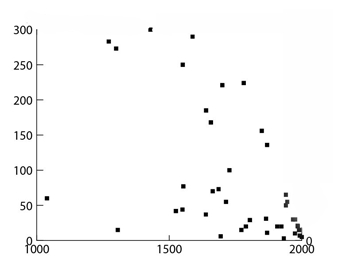The Futility of Prohibition
The most common response toward an undesirable technology is to ban it. Over the centuries societies have declared many technologies to be dangerous, economically upsetting, immoral, unwise, or simply too unknown for our own good. The remedy to this perceived evil is usually a form of prohibition; the offending innovation may be taxed severely, or legislated to narrow purposes, restricted to the outskirts, or banned altogether. The list of offending inventions banned on a wide scale includes such major items as crossbows, guns, mines, nuclear bombs, electricity, automobiles, large sailing ships, bathtubs, blood transfusions, vaccines, TV, computers, and the internet.
Of course many times an unwanted technology is simply that: unwanted. Few adopt it and it fades away. Thus some technologies are rejected by non-use. What is curious is that so few types of technology are rejected by any means. The default mode for a new technology is adoption. It is as if we really don’t have to say “yes” to new things. Unless we say “no,” they spread irreversibly in a resounding yes. Our only choice is to say no.
History shows that it is very hard to say no to technology. I recently examined all the cases of large-scale technology prohibitions that I could find in the last 1,000 years. I define large-scale prohibition as an official injunction against a specific technology made at the level of a culture, religious group, or nation, rather than as an individual or small locality. I found about 40 cases that met this criteria. That is not very many cases for 1,000 years. In fact it’s hard to come up with a list of anything else that has occurred only 40 times in 1,000 years!
Prohibitions against technologies are rare. They are hard to enforce. And my research shows, they don’t last much longer than the normal obsolesce cycle of accepted technology. A handful of prohibitions lasted several hundred years in an era when it took technology several hundred years to change. The gun was outlawed in Shogun Japan for a century, exploration sailing ships in Ming China for three centuries, and silk reeling in Italy for 200 years. Few others in history lasted as long. As the lifecycle of technology sped up the popularity of an invention could fade in a few years; prohibitions against technology naturally shorten as well.
The chart below plots the duration of a prohibition against the year when the prohibition started. It includes only prohibitions that have concluded. As technology accelerates, so does the brevity of prohibition.

Bans may not last, but the question of whether they are effective during their duration is a much harder question to answer as a whole. Many earlier bans were based on economic considerations. The French banned the manufacture of machine-made cotton fabric for the same reason the English cottage weavers banned wide looms during the Luddite rebellion – it hurt their agrarian household businesses. Economic prohibitions can achieve their goals in short term, but often aggravate the inevitable transition later.
If we take a global view of technology, prohibition seems very ephemeral. While it may be banned in one place, it will thrive in another. In a global marketplace, nothing is eliminated. Where a technology is banned locally, it later revives to global levels.
With the accelerated pace of technological succession – constant upgrades replacing more primitive versions before it – even the most well-meaning ban is unsustainable. Prohibitions are in effect postponements. You might be able to delay the arrival of a specific version of technology, but not stop it.
Some, like the Amish, find that delay useful enough. Others hope that a more desirable replacement technology might be found in the delay. That is possible. But where wholesale prohibitions do not work is when they are enacted to eliminate a technology seen as subversive or morally wrong – because it cannot be eliminated, only postponed.


